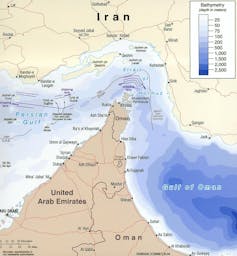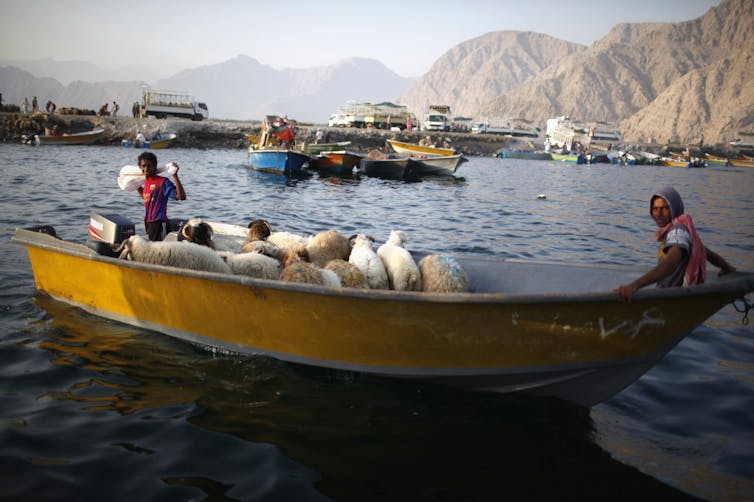Could Iran-US tensions mean troubled waters ahead in the Strait of Hormuz?
- Written by Rockford Weitz, Professor of Practice & Director, Fletcher Maritime Studies Program, The Fletcher School, Tufts University
Soaring tensions between Iran and the United States have reignited fears that the Strait of Hormuz could become a flashpoint as Tehran responds[1] to the killing of its top general[2].
Oil prices climbed[3] on news of the fatal airstrike, reflecting concern that any fallout could disrupt shipping in the narrow seaway through which 21%[4] of the world’s crude oil passes.
Meanwhile, the U.S. Maritime Administration issued an alert[5] over potential Iranian action against “maritime interests in the region” and the U.K. announced that the Royal Navy would resume escorting vessels through the Strait of Hormuz[6] as a precaution.
As a researcher who studies strategic maritime chokepoints[7] like this one in the Middle East, I have seen how past skirmishes in this waterway have fit into Iran’s use of hybrid warfare[8] – unconventional tactics that achieve strategic goals without triggering conventional military retaliation. In fact, Iranian leaders will likely feel tremendous political pressure to ratchet up maritime hybrid warfare[9] in response to the drone strike that killed the general.
A 21-mile-wide waterway
This 21-mile-wide channel connects the Indian Ocean with the Gulf. For all of recorded history, it has connected Arab and Persian civilizations with the Indian subcontinent and Pacific Asia. For example, before the rise of European seaborne empires in the 15th and 16th centuries, porcelain from China and spices from the Indochina peninsula often passed through the strait on the way to Central Asia and Europe.
 Strait of Hormuz.
Wikipedia[10]
Strait of Hormuz.
Wikipedia[10]
Today the Strait of Hormuz separates Iran from the countries of Oman[11] and the United Arab Emirates[12], which have strong military ties with the United States.
All shipping traffic from energy-rich Gulf countries[13] converges in the strait, including crude oil and liquefied natural gas exports[14] from Iran, Iraq, Kuwait, Bahrain, Qatar, Saudi Arabia and the United Arab Emirates.
This maritime chokepoint became an arena of conflict during the Iran-Iraq War in the 1980s. Each side in the so-called “Tanker War[15]” tried to sink the other’s energy exports. To avoid being targeted, Kuwaiti oil tankers were reflagged[16] under the U.S. shipping registry, obscuring their true ownership. Although crude oil continued to flow, marine insurance rates for vessels operating in the strait spiked by as much as 400%[17].
 Iranian smugglers in the strait in 2012.
REUTERS/Ahmed Jadallah
Iranian smugglers in the strait in 2012.
REUTERS/Ahmed Jadallah
Why is the strait a concern now?
The U.S. killing of General Qassam Soleimani has sparked fears that Iran could take action in the Strait of Hormuz as part of a retaliatory move – as they have threatened before.
Recent tensions in the Strait of Hormuz arose after the Trump administration’s decision to leave the Iran nuclear deal[18] in May 2018[19]. When Iran struck that accord in 2015[20] with the U.S., U.K., Russia, France, China, Germany and the European Union, it agreed to restrict its nuclear development in exchange for lifting economic sanctions against it.
By July 2018, Iran had threatened to close the Strait of Hormuz[21] to retaliate against the ratcheting up of U.S. sanctions[22] against it.
By engaging in hybrid warfare[23], Iran appeared to be disrupting trade flows through the Strait, raising diplomatic stakes in the process.
Notably, in June 2019 attacks on Japanese and Norwegian-owned oil tankers[24] coincided with Japanese Prime Minister Shinzo Abe’s visit to Tehran. Iran denied any involvement, but the U.S. released video footage it said showed Iranian special forces removing an unexploded mine[25] from one of the tanker’s hulls. If Iran was behind the attacks, it could have been a signal to Japan[26] and China[27] that they need to pressure the Trump administration to ease its sanctions against Iran – or risk disruptions to vital oil and gas exports to Asia transiting the Strait of Hormuz.
Could Iran close the strait?
In my view, Iran would certainly have trouble[28] stopping all shipping through the Strait of Hormuz. Modern cargo vessels are massive and difficult to disable. Unlike in the 1980s, most oil tankers now have double hulls, making them harder to sink. Furthermore, earlier this year the U.S. assembled a multinational coalition[29] to monitor and respond to threats to commercial shipping in the strait.
Iran will also be wary of the impact that closing the Strait of Hormuz could have on its relations with important economic partners, such as China. It is estimated that 76% of crude oil passing through the waterway is destined for Asian markets[30], with China, India, Japan, South Korea and Singapore among the largest markets.
In the past both the U.S. and Iran[31] have pivoted back to diplomatic solutions[32] when tensions have become too high, suggesting that neither side wants to see the conflict escalate from hybrid warfare into a full-blown war.
Portions of this article appeared in a related article published on July 19, 2019[33].
References
- ^ responds (www.startribune.com)
- ^ killing of its top general (www.washingtonpost.com)
- ^ Oil prices climbed (www.theguardian.com)
- ^ 21% (www.eia.gov)
- ^ issued an alert (www.maritime.dot.gov)
- ^ would resume escorting vessels through the Strait of Hormuz (www.maritime-executive.com)
- ^ a researcher who studies strategic maritime chokepoints (link.springer.com)
- ^ hybrid warfare (www.usni.org)
- ^ ratchet up maritime hybrid warfare (time.com)
- ^ Wikipedia (commons.wikimedia.org)
- ^ countries of Oman (www.thenational.ae)
- ^ United Arab Emirates (www.reuters.com)
- ^ energy-rich Gulf countries (www.eia.gov)
- ^ liquefied natural gas exports (www.rigzone.com)
- ^ Tanker War (www.usni.org)
- ^ tankers were reflagged (www.jstor.org)
- ^ as much as 400% (www.nytimes.com)
- ^ Iran nuclear deal (www.bbc.com)
- ^ May 2018 (www.vox.com)
- ^ that accord in 2015 (www.businessinsider.com)
- ^ threatened to close the Strait of Hormuz (www.realcleardefense.com)
- ^ U.S. sanctions (www.treasury.gov)
- ^ hybrid warfare (globalsecurityreview.com)
- ^ June 2019 attacks on Japanese and Norwegian-owned oil tankers (www.vox.com)
- ^ unexploded mine (www.politico.com)
- ^ Japan (www.apnews.com)
- ^ China (www.voanews.com)
- ^ Iran would certainly have trouble (www.foreignaffairs.com)
- ^ a multinational coalition (www.economist.com)
- ^ 76% of crude oil passing through the waterway is destined for Asian markets (www.eia.gov)
- ^ both the U.S. and Iran (www.pbs.org)
- ^ diplomatic solutions (www.reuters.com)
- ^ July 19, 2019 (theconversation.com)
Authors: Rockford Weitz, Professor of Practice & Director, Fletcher Maritime Studies Program, The Fletcher School, Tufts University

